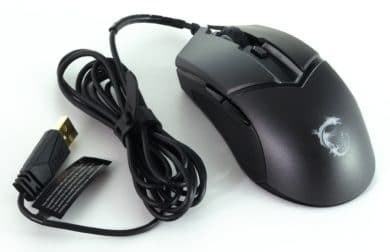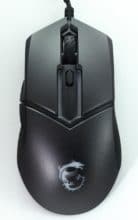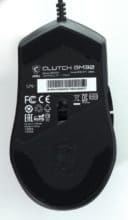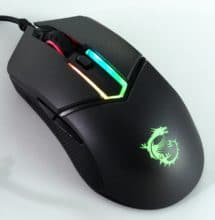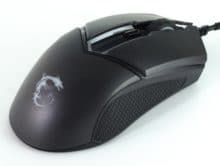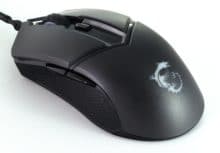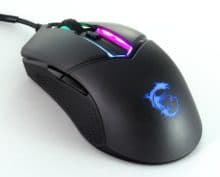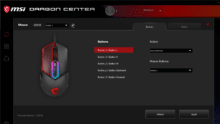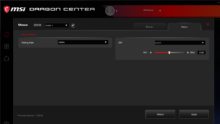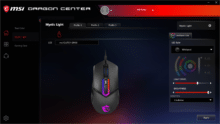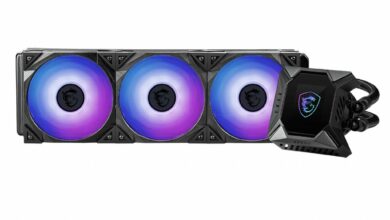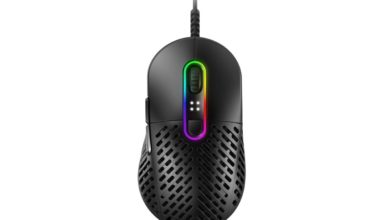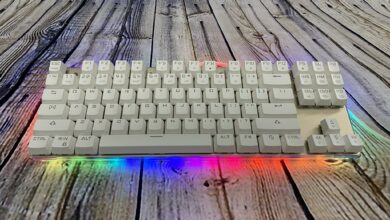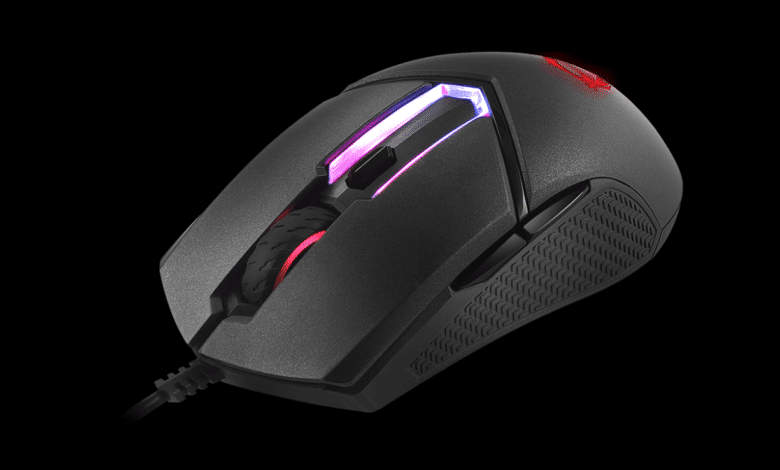
In September MSI launched a new mouse, the Clutch GM30, which is positioned in the price range around 40 Euro – currently the model is available for € 70.00 *. In return, MSI promises extensive RGB lighting and a PixArt PAW-3327 as a sensor with up to 6,200 DPI. Additionally there are the usual Omron buttons under the two main buttons as well as Huano switches for the side buttons.
The following test will show whether the chosen combination is sufficient to make the Clutch GM30 a good choice in this highly competitive price segment.
Scope of Delivery
In terms of the scope of delivery, MSI sets great store by the minimum, in line with the price: apart from the mouse itself, there is only a user manual in the colourfully printed cardboard box, no other accessories are included.


Design and Workmanship
The MSI Clutch GM30 is based on a basically symmetrical case with two thumb keys placed exclusively on the left, so that the mouse is only really suitable for right-handed users. As usual, a third additional button is located behind the rubber mouse wheel and is used for changing the DPI.
The body of the mouse is mostly made of smooth, matt black plastic. MSI promises an anti-slip surface on both sides; in practice, this is simply two structured areas. As a third surface type, the Clutch GM30 also has accents made of high-gloss plastic: this can be found both on the top of the additional keys and on a strip on the back of the mouse. The mouse’s workmanship is impeccable throughout: the housing is optically perfect and the individual parts are firmly connected to each other.
In the targeted price segment of the Clutch GM30, MSI of course has to set certain priorities, because to satisfy all demands, the cost-related restrictions are simply too high. Instead of using a particularly good sensor or extensive equipment with additional keys, MSI relies on prominent RGB lighting for the mouse. This is achieved in particular by a U-shaped area on the back of the mouse.
The area in question is illuminated by a total of seven RGB LEDs, which can be controlled individually and thus enable clean color transitions and a fairly even brightness distribution. The two usual RGB LEDs under the logo on the back of the mouse and on the mouse wheel are also installed. Those who prefer an outstanding RGB lighting will get their money’s worth here.
Practice
MSI uses the relatively rarely used sensor PAW-3327 from Pixart in the clutch GM30. It promises a maximum acceleration of 30 g and a maximum speed of 220 ips, so that the model is lagging behind the PMW 3360 on paper. The PMW 3360 can already be found on some mice in the same price segment, but they then rely on much less pronounced RGB lighting or cut other functions.
According to Pixart, the PAW-3327 offers a maximum resolution of 6,200 DPI and MSI makes full use of this. There is no software interpolation for even higher values. In practice, the sensor does a good job: Movements are detected precisely and without a lot of noise. An optional angle snapping is not available with the sensor.
According to MSI, the Clutch GM30 is particularly suitable for the Palm and Claw Grip. We can confirm this classification: The shape of the case favours both grip techniques and makes playing pleasant, whereas the fingertip grip on the mouse is not really pleasant. For the latter, the mouse falls off too quickly at the back.
In practice, the anti-slip surface on both sides advertised by MSI provides a high friction resistance, making slipping less likely. If you have (very) sensitive fingertips, you may also have difficulties with the rough surface if your fingers rub against the surface. Normally this should not be a problem.
MSI is pleasantly surprised when it comes to the button configuration, although this wasn’t to be expected from the data sheet: Omron buttons with a lifetime of 20 million releases are nothing unusual in this price range, and since the mouse is limited to the usual minimum configuration, it can’t really stand out here either. However, the five built-in keys all offer a very defined pressure point, are easy to operate and easy to reach – so the mouse is completely convincing here.
Software and Lighting
The Clutch GM30 can be configured using the MSI Dragon Center, which is also used for other MSI products such as motherboards. The program itself is installed quite quickly, but before starting it you have to download an SDK, which in turn requires a restart.
The Dragon Center is also a bit more cumbersome than necessary during operation, which is due to its design: The software is used to configure all MSI products, which is why the general point “Lighting” is listed separately. Anyone who increasingly uses MSI hardware will appreciate this, because this solution simplifies lighting adapted between all components. However, if you only buy the mouse, you always have to change the menu with this solution – it’s a bit cumbersome. We could also do without the recurring request to register with MSI.
Apart from these small shortcomings, the mouse offers an average setting package: The various keys can be reconfigured and assigned macros, and the five DPI profiles can be adjusted in 100 increments in the range between 600 and 6,200 DPI.
For the illumination, MSI offers several dynamic effects that can be adjusted in terms of speed and brightness. Mystic Light is also available, allowing the effects to be displayed across different components. Only a direct control of the individual RGB LEDs for a multicolored, static illumination would have been nice.
Conclusion
With the Clutch GM30, MSI offers a mouse that has to compete for a price of € 70.00 * Euro in a highly competitive market. The mouse prefers lighting in particular, but the device can also surprise in other areas: The ergonomics in the claw and palm grip have been successful, and the buttons are consistently easy to reach and offer a very pleasant and defined click feeling.
The mouse doesn’t set new standards for the sensor: The built-in PAW-3327 does a solid job, but of course it can’t keep up with the higher quality models from Pixart. Mice that offer such sensors in the same price segment, however, cut back other functions. A more expensive sensor is therefore not really to be expected with the Clutch GM30.
The bottom line is that the Clutch GM30 can be recommended for exactly the target group that MSI wants to appeal to: If you like the prominent RGB lighting, you will get a solid mouse that scores especially with the implementation of the keys. Only the software offers real potential for improvement: A somewhat faster installation and a less prominent registration request would have been nice.
MSI Clutch GM30
Workmanship
Features
Ergonomics
Software
Value for Money
The Clutch GM30 can convince in particular by the keys and the RGB lighting.


